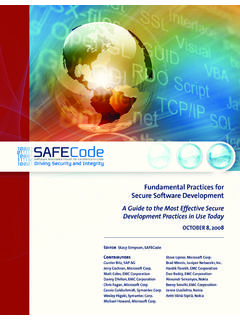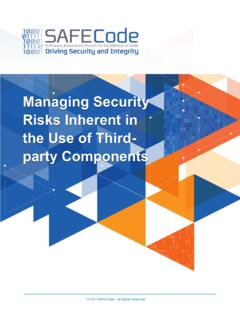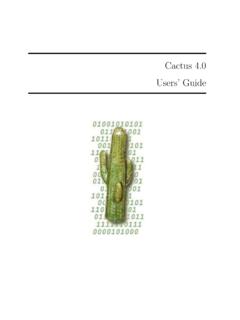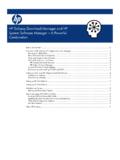Transcription of Software Assurance: An Overview of Current …
1 Software Assurance: An Overview of Current Industry Best PracticesFebruary 2008 Executive SummarySoftware Assurance: An Overview of Current Industry Best PracticesSoftware underpins the information infrastructure that govern-ments, critical infrastructure providers and businesses worldwide depend upon for daily operations and business processes. These organizations widely and increasingly use commercial off-the- shelf Software ( COTS ) to automate processes with information technology. At the same time, cyber attacks are becoming more stealthy and sophisticated, creating a complex and dynamic risk environment for IT-based operations that users are working to better understand and manage. As such, users have become in-creasingly concerned about the integrity, security and reliability of commercial Software . To address these concerns and meet customer requirements, vendors have undertaken significant efforts to reduce vulner-abilities, improve resistance to attack and protect the integrity of the products they sell.
2 These efforts are often referred to as Software assurance. Software assurance is especially impor-tant for organizations critical to public safety and economic and national security. These users require a high level of confidence that commercial Software is as secure as possible, something only achieved when Software is created using best practices for secure Software white paper provides an Overview of how SAFECode mem-bers approach Software assurance, and how the use of best practices for Software development helps to provide stronger controls and integrity for commercial applications. Table of Contents The Challenge of Software Assurance and Security 4 Industry Best Practices for Software Assurance and Security 7 Framework for Software Development 9 Software Security Best Practices 12 Related Roles of Integrators and End Users 16 SAFECode s Goals 18 Conclusion 18 Questions for Vendors about Product Assurance and Security 19 About SAFECode 20 4 5 The Challenge of Software Assurance and SecuritySoftware assurance encompasses the development and implementation of methods and processes for ensuring that Software functions as intend-ed while mitigating the risks of vulnerabilities, malicious code or defects that could bring harm to the end user.
3 Software assurance is vital to ensuring the security of critical information tech-nology resources. Information and communications technology vendors have a responsibility to address as-surance through every stage of application paper will focus on the Software assur-ance responsibilities of Software vendors. However, integrators, operators and end users share some responsibility for en-suring the security of critical information systems. Because of the rapidly changing nature of the threat environment, even an application with a high level of qual-ity assurance will not be impervious from attack if improperly configured and main-tained. Managing the threats we face to-day in cyberspace requires a layered system of security, with vendors building more secure Software , integrators ensuring that the Software is installed correctly, operators maintaining the system properly, and end users using the products in a safe and secure Software Assurance Definition:Confidence that Software , hardware and services are free from intentional and unintentional vulnerabilities and that the Software functions as intended.
4 4 5 The dynamic threat environment creates challenges for all Software -related opera-tions. Vectors for attacks that could interrupt or stop critical Software functions must be considered in design and development. The Software assurance risks faced by users to-day can be categorized in three areas:Accidental design or imple-1. mentation errors that lead to exploitable code vulnerabilitiesThe changing technological 2. environment, which exposes new vulnerabilities and provides adversar-ies with new tools to exploit them Malicious insiders3. who seek to do harm to users or vendorsAccidental Design or Implementation ErrorsThe prevalence of hackers, viruses, worms and other malicious Software that attack systems and networks highlights the first risk area when programmers inadvertently create faulty Software design or implemen-tations. Developers address this risk through developer training and the use of secure development practices and tools.
5 These processes are discussed in depth in the next section of this Changing Technological EnvironmentRapid change and innovation are two of the most enduring characteristics of the IT industry. But innovation is not unique to vendors. Criminals can and do innovate. In the span of only a few years a complex and lucrative criminal economy capable of sup-porting specialized skill sets for identifying and attacking Software has development of this sophisticated crimi-nal economy contributes to increasingly tar-geted and complex attacks. Vendors commit resources to understand emerging threats and use state-of-the-art technologies, tools and techniques to develop Software , hard-ware and services that can resist attack. The process is one of on-going improvement as new vulnerabilities are exposed, new threats are created and new countermeasures de-veloped and Risks and Countermeasures 6 7 Malicious InsidersThere is a growing concern that global Software development processes could be exploited by a rogue programmer or an or-ganized group of programmers that would compromise Software , hardware or services during the development process.
6 Vendors are extremely protec-tive of their soft assets such as their code base. The complex development process and the series of controls used to pro-tect the development process provide powerful management, policy and technical controls that reduce these risks. There is no single way to manage or control a development process. Rather there are proven best practices that companies use to manage their unique development infra-structure and business members implement processes for vetting employees and contractors regardless of their country of residence. How-ever, far more critical to soft-ware assurance is establishing and implementing processes and controls for checking and verify-ing Software assurance irrespec-tive of where it was produced. From a development perspective, these con-trols are focused more on how it was made than where they were sitting during the coding STUDYEMC CorporationA centralized Product Secu-rity Office coordinates inter-related programs for strong security assurance at EMC : Product Security Policy Guides product development teams and is a common reference for product organizations to benchmark product security against market expectations and industry best practices.
7 Metrics score company-wide use of the : Security Training Role-based security engineering curriculum trains new and existing engineers on job-specific security best practices and how to use relevant : Security Devel-opment Lifecycle Over-lays security on standard development processes for achieving a high degree of compliance with the above referenced Product Security : Common Security Platform A set of Software , standards, specifications and designs for common Software security elements such as authentica-tion, authorization, audit and accountability, cryptography and key management using state-of-the art RSA technol-ogy. An open interface allows integration with customers security Response: Prod-uct Security Response Center Defines and enforces EMC s vulnerability response policy to minimize risk of exposure to Validation: Secu-rity Certification EMC has received extensive govern-ment and industry certifica-tions in design, implementa-tion and management of its security processes and solu-tions including Common Criteria or FIPS 140-2.
8 6 7 These risks can all be managed through the adoption of best practices in Software assur-ance. While a number of international stan-dards and certification regimes for Software assurance have been issued, their effective-ness in achieving real-world reduction in vul-nerabilities is debatable. Companies on their own have been taking the lead in developing and implementing practices to produce se-cure code that are better tuned to real-world Software development processes and result in higher levels of security. SAFECode s mis-sion, in part, is to bring these practices to-gether to share across the Risk Through Software Assurance Best PracticesIndustry Best Practices for Software Assurance and SecuritySoftware vendors have both a responsibil-ity and business incentive to ensure product assurance and security. Customers demand that Software be secure and reliable.
9 Ven-dors also must produce quality products to protect and enhance brand names and com-pany reputations. These pressures motivate vendors to minimize mistakes in coding, reduce the occurrences of post-sale vulner-abilities and related patching, and to protect sensitive data and the operational integrity of customer IT understand how vendors are earning the trust of customers, it is useful to examine best practices employed by the Software in-dustry and how they contribute to enhancing product assurance and security. Software development processes vary by vendor according to their unique product lines, organizational structures and customer requirements. Not surprisingly, there is no single method for driving security and integ-rity into and across the globally distributed processes that yield technology products and services. Yet regardless of the method used, there is a core set of best practices for Software assurance and security that apply to diverse development environments.
10 CASE STUDYSYMANTEC CORPORATIONS ymantec s product security frame-work, called Product Security Life Cycle (PSLC) shapes and governs the lifespan of products. It has nine steps: engagement and preparation, educa-tion and training, security goals and planning, risk assessment, adoption of best practices, building automated routine verifications, security testing, security readiness review and security of the PSLC includes a series of extensive training classes about security awareness, secure development and security testing for members of the development and qual-ity assurance teams. This knowledge is applied with state-of-the-art tools for effective and secure source code con-figuration management, product build, source code analysis, product test and defect remediation. Engineers routinely compile and check code modules and the entire system. Security testing is performed by quality assurance teams and a product security components and open source Software used in this company s products are subjected to additional requirements:Teams check all code for vulner- abilities using standard methodolo-gies and tools;Providers are required to allow ac- cess to source code and/or that its vendor scan the code for common vulnerabilities;Teams have a documented, con- tractual service level agreement for security patches;Third-party code is implemented in a way that facilitates independent efforts have earned leadership for this vendor in the certifications community.








